#hemerythrin
Explore tagged Tumblr posts
Text
every day I'm a little bit more agitated by the fact I do not know what color majiri blood is and can only take educated guesses.
#pink??#is it pinkish#is it Purple#is it purple-y#is it hemerythrin.#are they like peanut worms are they WORMS#S6 answer me#this is fueled by Einar saying red is specifically like human blood
14 notes
·
View notes
Text
3 kinds of alien in the 30th century: rubber forehead, bug monster, and bojack horseman

#losh#legion of super heroes#dorite reads losh#also holy fuck they murdered a lot of people#such a great diversity of blood pigments tho#spotted not just hemoglobin but hemocyanin hemerythrin and vanadium chromagen
1 note
·
View note
Text

Everyone is mad.
Bug Fact: Deep-sea Peanut Worms have purple blood. The hemerythrin chemical gives the worm its purple hue and also gives it the ability to regenerate should it lose part of its body. Photos Below
V2 First || Prev // Next
Volume 2 Masterpost ▴♥︎▴


#Sam is getting on Dewi's nerves. You can't just SAY you want to kill bugs!!!#Dung Defender is out of walking practice. Man is build like a bowling ball.... plus humans can pass a football field in like 2 big strides.#Hornet said a very bad word#I love drawing the bigger shots where it shows the whole city in comparison to the humans. It gives a great sense of scale.#BUG CITY MENTION#Dewi's Adventures in Hollow Knight#Dewi's Adventures in Hollow Knight V2#hollow knight humans#comic#hollow knight au#Lilybug Comics#art#Hollow Knight#hk fanart#hollow knight comic#hollow knight art#hk art#hk au#sam#dewi#my art
1K notes
·
View notes
Text
Intro to Alternian Biology: respiratory pigments
Like the blood of most species on Earth and Alternia, trolls' blood derives its color from metalloproteins used to transport oxygen. Unlike most species on Earth and Alternia, troll blood contains multiple types of oxygen-transport proteins--five in total.
HEMERYTHRIN is the primary oxygen-transport protein in the blood of seadwelling trolls, and is also present in significant concentrations in purplebloods. It is violet-pink when oxygenated. Much Alternian sea life uses hemerythrin as its sole or primary oxygen transport protein, as do many Earth marine invertebrates.
HEMOCYANIN is the primary oxygen-transport protein of landdwelling highbloods (blue and purple) and present in significant concentrations down to olive. It is dark blue when oxygenated. Hemocyanin is also found in the blood of many Earth mollusks and arthropods.
CHLOROCRUORIN is present in very small quantities across the hemospectrum, and in high concentrations in greenbloods; it was the primary blood pigment in limebloods, which are now extinct. Chlorocruorin is a dichromatic compound which appears light green in dilute solutions, including normal blood, and red when highly concentrated; an uncommon mutation causing extreme overproduction of chlorocruorin thus results in bright red blood. On Earth, chlorocruorin is mostly found in worms.
COBOGLOBIN is an important oxygen-transport protein in low and midblood trolls and is most highly concentrated in goldbloods, the only caste for which it is primary, with significant concentrations occurring in every hemotype from rust to teal. It is yellow-orange in color when deoxygenated. Coboglobin is the only Alternian blood protein that does not occur in Earth biology.
HEMOGLOBIN is the primary oxygen-transport protein in rustblooded trolls. The highest concentrations occur in burgundy bloods, and it is present in significant quantities in all blood castes up to olive. Fuschiabloods also have hemoglobin in relatively small but still significant quantities, notably more than in any of the other high blood castes. It is dark red when oxygenated. Nearly all Earth vertebrate species rely on hemoglobin for oxygen transport.

Additional notes:
The gray color of trolls' skin comes from black eumelanin and blue-gray carotenoproteins in the skin cells, the concentration of which increases with age. The yellow color of trolls' irises comes from yellow carotenoproteins. These are present in most troll tissues, but their color is usually masked by the darker skin pigments or the more vivid blood pigments. They do, however, contribute to the color of yellow blood, the only hemotype dominated by a transport protein which is colorless when oxygenated.
High concentrations of chlorocruorin are correlated with conciliatory impulses. Sopor slime is a highly oxygenated fluid containing significant concentrations of chlorocruorin, which give it its green color and are believed by many to contribute to its dampening effect on sleep rage and daymares, though the mechanism is not known. No surviving castes have as much as 50% chlorocruorin, while the now-extinct lime bloods had just over. Trolls with the rare cherry red mutation, however, have over 90% chlorocruorin, twice as concentrated as any other surviving caste.
It has been theorized that the cherry red mutation is a throwback to a now-extinct subspecies of troll which relied solely on chlorocrourin for oxygen transport. There were many subspecies in Alternia's evolutionary past, some more successful and widespread than others. In prehistory it is thought that none used more than one oxygen transport protein, as is typical in most planetary ecologies including Earth's. However, early hybrids benefited from the adaptive advantages of diversifying oxygen transport, and the mixing of subspecies through kleptogenetic reproductive strategies eventually resulted in the distribution of diverse respiratory pigments seen in the modern hemospectrum.
285 notes
·
View notes
Note
favorite word?
idk if u meant to ask my kirby blog but I don't have a favorite word. However this reminded me that I have loved the mouthfeel of Carbon Dioxide for a very long time. And this in turn reminded me that I've been really into carbon monoxide poisoning recently like just as a concept. Which in turn reminded me I've been fiddling with the biology of Magolor's species again and I've decided that their blood uses a mixture of Hemerythrin and Erythrocruorin as oxygen carriers, to rly play up the He Is An Alien vibes (most large complex organisms in this region of space uses Hemoglobin). Hemerythrin doesn't bind to Carbon Monoxide as readily as Hemoglobin does, so in theory a creature that uses hemerythrin would have a higher tolerance for CO than an Earth human would. And I think it would be really funny if the Lor didn't have carbon monoxide detectors.
Anyways I think my favorite word might just be "Oxide" maybe perhaps
22 notes
·
View notes
Text
noticed something kinda interesting in my rewatch of Full Circle on the S18 DVD. The Marshmen have purple veins and flesh. like purple blood. So I propose: Adric with purple blush and blood. I don’t care if we literally see him with red blood in the same story, I don’t care, his blood is going to be purple because I make the rules now and think it’s look cute if his blush was purple naturally. maybe it would go against their weird evolution shit where they would evolve red blood in mimicking the Teradonains and to adapt to higher-oxygen environments, or something.
I did a lil googling, and purple blood requires a whole different protein instead of hemoglobin, instead being hemerythrin. I really like making Adric more alien-y or more similar to his marshmen ancestors, so fuck it! I doubt they evolved a whole different blood protein just for living on land, so sure! They got that weird purple blood!
#I am very tired so I hope this shitty this ambling makes any sense when read by someone other than me#no one else is gonna give a shit about Alzarian Blood Color other than me#so I can’t wait to get a whole 3 likes before this post sinks into the oblivion of my blog#doctor who#classic who#adric of alzarius#dw headcanon#Alzarius
24 notes
·
View notes
Note
Did oni have different types of horns?
What sort of homes and environments did they pick?
What did they eat?
What are you hc when it comes to oni?
1 - they probably did! oni were described as having bovine horns, which tend to vary greatly depending on the breed and species of the bovine.

here are some good examples :D it's also been stated that oni can have one horn or more, though they are usually depicted with two short, curved horns
2 - oni are known to live in various places, surprisingly. they reside in hell, torturing people and acting as guards. they can also live in abandoned fortresses or homes, remote mountain ranges, deep in sprawling caves, and surprisingly enough, even an island. there was an island called Onigashima (lit. oni island) in one story of japanese folklore, which was inhabited by a tribe of oni
3 - Oni were omnivorous, with a particular preference for eating humans and drinking saké (japanese rice wine). though they would also steal livestock and eat them, and in one particular legend an oni was very fond of garlic of all things, though that was unique to that oni
4 - ooo!! i have so many oni headcanons, but i'll give you one of my more specific ones! i think that oni have purple blood due to their bloods protein being hemerythrin rather than hemoglobin :D this affectively makes them immune to most poisons. another headcanon i have is that oni tend to fight very theatrically, since their entire culture is practically built around fighting. a common past time for oni is attending arenas and watching fights, either between two casual oni for the entertainment of the crowd, or between high ranking oni fighting for the rank of warlord, or as a tribute to the goddess that created oni, Izanami. and one more random headcanon i have is that oni actually speak japanese rather than ninjargon, seeing as they are from japanese mythology
thank you for the asks!!! :DDD
#RUCKER YOU ALWAYS HAVE THE PERFECT QUESTIONS WIDNSMSHSBDD#ninjago#lego ninjago#ninjago oni#oni lore#greens oni lore#oni
16 notes
·
View notes
Text
Scientifically Justifying Why Kai'Sa's Eyes are Purple, and Why I Think Her Blood is Too
preface: I wrote this starting in reference to K/DA-verse Kai'Sa, but these justifications also work for her base Runeterra form. I'm also not a scientist or anything of the sort.
I started with trying to determine if purple blood was possible, and then went down the rabbit hole ->


Purple Blood:
sources: 1 2 3
Red blood in humans and blue blood in crabs and such is because of the specific element in their respiratory pigment molecule - iron in hemoglobin for humans, copper in hemocyanin for crabs. Purple blood happens w hemerythrin found in marine worms, but it sucks at oxygen transfer, as does hemocyanin in comparison with hemoglobin. So it wouldn't really efficiently sustain a whole human body like Kai'Sa's.
BUT! The Void doesn't exist irl, so we can make stuff up! I propose now that Void structures contain a new element — an addition to the transition metals section of the Periodic Table (like iron and copper.) One source (2) does propose that manganese could produce purple blood, but I think since we're dealing with something already not found on Earth, we can add to reality a bit.
This can also account for the more metallic look that the second skin takes in the MORE video, which is how I believe the Void more generally manifests in K/DA-verse, instead of the purple and dark chitin that happens in Runeterra.

Sidenote: the directors of the MV did say in a making-of talk (currently paywalled, but I did watch when it first came out.) that their understanding of the second skin (and what they were told, iirc?) was that it mimics the texture of what she touches, which is interesting, and aesthetically it matches the ALL OUT era (see: Ahri's tails) (omg kahri canon?) — but personally I'm choosing to stretch this to serve my own needs because these are my headcanons and I can do what I want lol. I believe the second skin has a silver scale-like texture but the Void still retains its purple nature to account for her blood and eyes, which I'll get to in a minute.
So with this new metal element, Kai'Sa's respiratory pigment molecules in her blood can reflect back purple blood and still let her live. I don't think it's a bright violet, still not far away from red, but distinctly a shade of purple.
"Wouldn't that mean her skin appears purple?"
Probably yeah... which should be more true for her Runeterra form where she's been more augmented by the Void, but for K/DA-verse where she still has a human skin tone? How do I explain that?
Simple: I'm making stuff up lol
My take on K/DA Kai'Sa's Void "infection" is that it was super quick, one hand in some Void-sludge, not a decade long stay underground like she goes through in Runeterra, so she arguably has been affected by it less. Maybe her veins and skin absorb different colors so it reflects back normally, like how Bel'Veth attempts to appear human, the Void wants to disguise itself? So when it comes in contact with humans it alters those so that the purple doesn't come through? Take your pick lol
(sidenote: this could potentially justify whatever the hell is going on with Kassadin's skin/armor/whoknows)
It's only oxygenated blood of crabs that appears blue, before that it's colorless, and hemoglobin goes from bright red to dull red in the same process, so it's not unreasonable to suggest that Void blood only looks most purple when it's oxygenated — notably, when Kai'Sa bleeds.
Eye Color:
my sources for this section were mainly multiple wikipedia articles that I will link in text when relevant. This paper was also helpful, as was this.
Kai'Sa has purple eyes, in both Runeterra and K/DA-verse, that I headcanon to have changed from brown as a result of the Void's influence.
No, the Void did not give her the fake tumblr purple eye condition, but in combination with now-purple blood, and Void creatures' lack of a need for melanin, it makes sense.
The Void is dark and underground, there's little to no light to be filtered or protected against - the general function of melanin. Runeterra Kai'Sa would definitely go pale after 10 years below. Also of note is that Rek'Sai literally doesn't have eyes; light is not important down there.
So with that in mind: Eye color is determined by melanin levels in the iris, and when there's less of it, less light is absorbed. The lower layer, the iris pigment epithelium is dark with melanin, above (meaning closer to the surface) which is the stroma of the iris, which also contains melanin, but the level varies and thus different colors are reflected back. The light that the stroma reflects back is of shorter wavelength, which is what causes blue eyes, but you know what visible light color has a shorter wavelength than blue?
Purple!
This reflection and light scattering is structural, not pigments — a structure the Void can alter.
This is what's fun about this, I can find a real world explanation that almost goes far enough, but then the otherworldly nature of the Void allows me to take the final leap! But also, I'm not done yet because the blood is relevant again.
"But if Void creatures lack melanin, isn't that albinism and her eyes would be red instead?"
Valid conclusion to draw, but I'm again pulling my This Isn't Real And I Can Do What I Want card, and say that not all of Kai'Sa's DNA has been altered, we're just talking eyes, not hair or other melanin-affected things, but also, the red eyes of albinism are the reflected light blood vessels of the retina showing through because of the lack of melanin in the iris and retina, and remember: Kai'Sa's blood is purple now!
Or, you know, all of this happens because magic and art design or whatever anyway
I spent about 5 hours researching and writing this, I hope it was enjoyable to read?
TL;DR: Kai'Sa's blood can be purple if she has a different element in her blood. Her eyes can be purple because the Void doesn't need melanin so her iris reflects shorter wavelengths of light.
#another episode of tanner thinks way too much about league of legends and has too much time on their hands#league of legends#kai'sa#the void#lore reference#tanner talks#i really hope this was worth reading i'd love to know what other people have to say about it! hopefully nothing is straight up wrong#i know so much about how eyes work now lmaooo the things i do for my favorite character
6 notes
·
View notes
Note
Out of the blue, but I'm curious..Do you have any fun facts that you enjoy telling people?
[I DON'T TALK TO PEOPLE MUCH. NO VOICE AND IM USUALLY KILLING THEM INSTEAD
I HAVEN'T BEEN ON HERE LONG ENOUGH TO HAVE A DEFAULT FACT TO GO TO]

...
[THE MAIN THREE O2-BEARING BLOOD PROTEINS ARE HEMOGLOBIN, HEMOCYANIN, AND HEMERYTHRIN. HEMOGLOBIN IS THE FAMILIAR RED, WHICH I GUESS YOU ALREADY KNOW UNLESS YOU'RE A MOLLUSC OR SOMETHING. HEMOCYANIN IS BLUE WHILE OXYGENATED, AND HEMERYTHRIN IS PINKISH-PURPLISH OXYGENATED.]
[I CAN'T METABOLIZE HEMOCYANIN, SINCE IT'S COPPER-BASED, BUT I CAN USE HEMERYTHRIN. IT'S JUST LESS EFFECTIVE SINCE IT DOESN'T HAVE A HEME IN SPITE OF ITS NAME IMPLYING IT DOES]
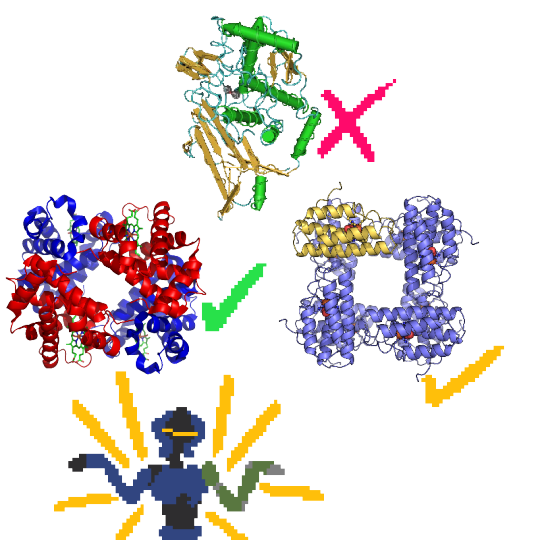
[NEVER DOUBT THE VALUE OF A GLOBIN FOLD]
#[RESPONSE]#[OPPONENT:ANONYMOUS]#[I WONDER IF HEMOCYANIN WOULD HAVE HAD ANY VALUE TO MY CIRCUITRY?]#ultrakill ask blog
3 notes
·
View notes
Text
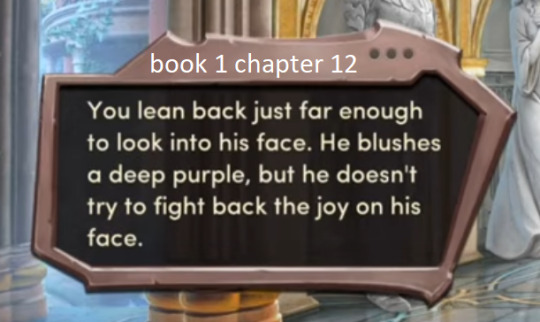
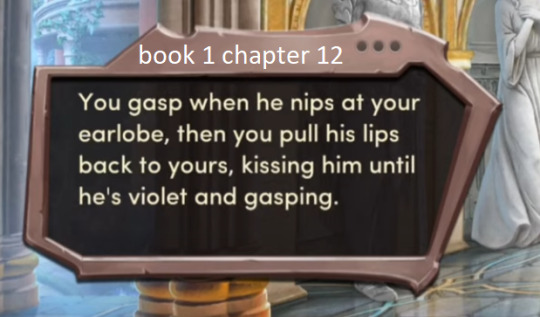
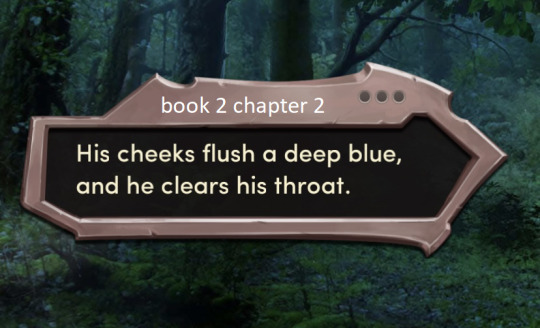
Interesting.. the colour Tyril blushes with has changed? 😮
In all likeliness it's just a teency continuity error, because who sits there memorizing the colour of a man's blush (except me, but I am an outlier, and should not have been counted.)
But it does leave me wondering - what is the colour of this man's blood? 🩸
(theories and headcanons under the cut!)
The colour from blush comes from your blood beneath your skin, your skintone does contribute to the overall appearance of your blush, but Tyril's skin is a very light pastel blue and I'm no scientist, but I don't think such a pale blue would have as much of a bearing over the colour of his blush to turn it fully blue, if his blood were red. With red blood and pastel blue skin, I (not a scientist) might expect maybe a lilac or a purple blush like he's described to have in book 1?
But it being described as a blue blush in book 2 suggests that he could have blue blood, which is fascinating to me, I might have my facts wrong but octopi and crabs have blue blood instead of red because the makeup of their blood is slightly different. So us humans have haemoglobin in our blood, which contains iron, and when iron reacts to oxygen, it turns red, which is why our blood is red, and why rust is red.
But octopi and crabs have hemocyanin in their blood, hemocyanin contains copper instead of iron, and oxidized copper is blue. I can only assume hemocyanin is called that because cyan is a shade of blue.
...Huh.
So we have a case for him having red blood, and his blush just looks purple because of his blue skin on top (once again, not a scientist), or blue blood, but also, we could have a case for him having purple blood, because he does blush purple in book 1 and when he gets injured by the ghasts in one chapter it says a strange purple substance comes out.
Although I hesitate to consider the strange purple substance his blood, given the nature of the injury and how it was made out not to be a natural type of injury because it was magical. Also, though this could definitely be chalked up to it being a game and this being such an inconsequential and unimportant variable that it's not worth including when you consider all the much more important variables to program and test, but the description of the substance is always strange, even if you are playing as a blue elf MC, and Tyril is a blue elf, so, if we were to assume that their blood colour is the same, if that truly was his blood, why wouldn't the MC recognize that? So I'm not as set on his blood being purple because of that.
There are species in nature that have purple blood though, peanut worms have purple blood, because they have hemerythrin in their blood, which also turns purple in reaction to oxygen.
And in support of him having different coloured blood in general, we see a few different members of the shadow court bleed black blood, so different coloured blood is not completely unheard of in the book.
Most likely his blood is just red, but I do like thinking about the headcanon possibilities and whether or not the elves and the orcs could have different blood colours, or maybe even our MC.
#bolas#blades of light and shadow#tyril starfury#choices#playchoices#choices blades of light and shadow#blades of light and shadow 2#choices tyril#choices blades#choices bolas#choices stories you play#pixelberry#tyril x mc#bolas spoilers#blades of light and shadow spoilers
48 notes
·
View notes
Text
The Taco Slug

One of a revolutionary new group of multicellular organisms, the Taco Slug is a creature which has proliferated throughout the Uridachian Period.
Unlike the first metazoans on Astraea, Taco Slugs exhibit bilateral symmetry - that is, their bodies are exact mirror-matches when divided lengthwise. This symmetry has developed alongside their motility - these creatures move about on a single, muscular foot, which is coated in microscopic cillia and secretes a slimey substance. This allows Takolimax to stick to and climb most surfaces in their seafloor environments.
Like most metazoans at this time, Taco Slugs consume microorganisms. T. antiqua prefers to consume the microbial mats on shallow seabeds, while the subspecies T. vagnum consumes marine snow in deeper waters. In order to sense both its food and environment, taco slugs have developed a variety of sensory mechanisms to find their way. Two pairs of simple eyespots help surface species sense light, while deep ocean species have developed magnetotactic senses, relying on the magnetic field to sense north. Simple chemical receptors in the skin allow them to "taste" the surrounding water for foreign scents, and they can even sense changes in temperature, to a limited degree.
This active lifestyle has led to some notable adaptations regarding the Taco Slug's bodily functions. The various senses it uses to navigate have led to the development of a simplified nerve ganglion clustered towards the front of the animal, to help it better process the senses it receives. The need for motility has necessitated the evolution of blood - specifically, blood using the protein hemerythrin, which gives its blood a violet coloration. Further, the need to obtain oxygen from the water to facilitate its motility has spurred it to develop gills along its back, protruding from the fleshy lobes which give it its taco-shaped form. The need to protect all these various internal organs has necessitated the development of the first skin pigments, to further shield it from harmful solar radiation.
Taco slugs have been one of the most successful and prolific organisms on Astraea, having spread to most corners of the world's ocean habitats. Ongoing research into just what prompted these various adaptations has been thus far inconclusive, but these creatures seem to be on the verge of dominating most habitats they occupy. Further observations will surely reveal more of their secrets.
#The Astraea Project#Uridachian Period#Taco Slugs#Creature Profile#speculative evolution#speculative biology
7 notes
·
View notes
Text
"Eeeeh! You're all bathing in red. Where's the hemerythrin?! The hemocyanin?! The chlorocruorin? Or gossamer?! Add a little lampshell plum. Some squid blue? Leech green!"
Susan grumbles with disgruntlment.
"Hemoglobin red is boring. Everyday is red, red, red, red. Sky is red. Rain is red. Ground is red. Plants....ARE RED!"
1 note
·
View note
Text
hemerythrin tv screen anybody? weave together some tubes... gotta be something
0 notes
Text
oh there's so many guys to look at

thick-tailed doggy show me your faaace I need to know if you are a dragon

hross.

let me guess you are an alien humanoid with hemerythrin + vascularized skin?
0 notes
Text
Ahtapotların Kanı Neden Mavidir?
Ahtapotların Kanı Neden Mavidir?
Ahtapotların Kanı Neden Mavidir? Kan deyince muhtemelen hepimizin aklına kırmızı renk geliyordur muhtemelen. Kanı tuttuğu takımın renkleri akanlar hariç herkesin kan rengi kırmızıdır, bizim dışımızda omurgalı hayvanların çok büyük bir kısmı da kırmızı kana sahiptir. Ama omurgasız hayvanlara baktığımız zaman başka kan renkleri görebiliyoruz; mavi, mor, yeşil gibi. Kan rengini belirleyen temel…

View On WordPress
0 notes
Text
For Annelida:
Riftia pachyptila tube worms live on hydrothermal vents, have a symbiotic relationship with thiotrophic (sulphur-oxidizing) bacteria which allows them to not only shrug off but benefit from high levels of H2S, and can grow to nearly 10 feet long.
As far as I know, annelids are the only phylum in which all five of the major blood pigments (hemoglobin, hemocyanin, chlorocruorin, erythrocruorin, and hemerythrin) are present.
Bobbit worms exist. That is all.
Phylum Round 2
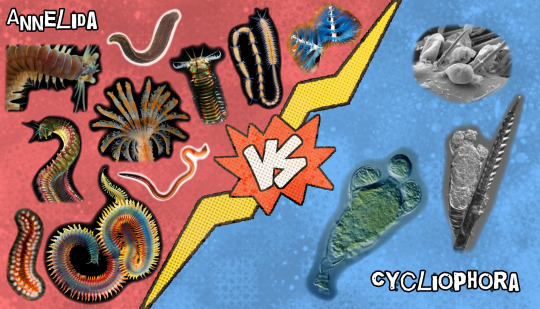
Annelida: Segmented Worms. This group includes earthworms, leeches, and many classes under the umbrella of "polychaete". This diverse phylum encompasses deposit feeders (eating dirt), detritivores, scavengers, deadly ambush predators, filter feeders, parasites, herbivores, and more. They are broadly defined by their repeating body segments and parapodia, which are nubby appendages used for both movement and breathing. Some have curved jaws for catching prey or scraping detritus off of rocks, while others have wide, elaborate feather-like fans for filter feeding. While able to crawl freely, a majority of marine Annelids spend most of their time in self-built tubes or burrows. Among their many important functions, they play a key role in mixing soil/sediment, breaking down decaying organic matter, and providing a key food source to countless other animals.
Cycliophora: An incredibly specialized phylum, the Cycliophorans consist of a single genus. These animals live exclusively on the mouthparts of lobsters. Yes, all Cycliophorans. This is considered a commensal relationship, as the lobster is not harmed by the Cycliophorans' presence. This phylum has an interesting reproductive strategy involving cloned dwarf versions of the male, embryos that drain all nutrients from the mother, and larvae that must be strong swimmers to hopefully re-colonize the host lobster's new exoskeleton whenever it molts.
#biology#animals#annelids#polychaetes#sorry if this is getting spammy but I do love to share animal facts#animal tournament
54 notes
·
View notes